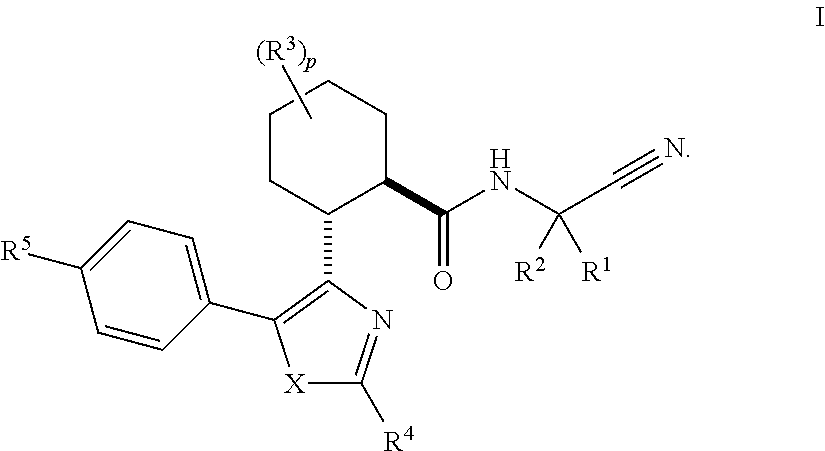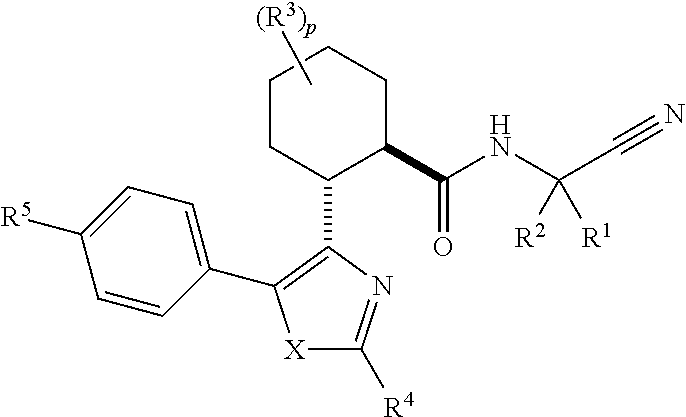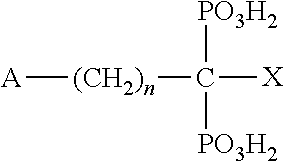Cathepsin cysteine protease inhibitors
a cathepsin cysteine protease and protease inhibitor technology, applied in the field of cathepsin cysteine protease inhibitors, can solve the problems of high risk of fracture, large segment of the older population already has low bone density, morbidity and mortality in the elderly population, etc., to achieve the effect of preventing cathepsin dependent conditions or disease states, reducing the risk of fracture, and improving bone turnover
- Summary
- Abstract
- Description
- Claims
- Application Information
AI Technical Summary
Benefits of technology
Problems solved by technology
Method used
Image
Examples
example 1
[0274]
(1R,2R)—N-(1-cyanocyclopropyl)-2-(2-(3,3-difluorocyclobutyl)-5-(4-(1,1-dioxidothiomorpholino)phenyl)thiazol-4-yl)cyclohexanecarboxamide (Compound 1)
Step A: 3,3-Difluorocyclobutanecarbonyl chloride
[0275]To a solution of 3,3-difluorocyclobutanecarboxylic acid (0.200 g, 1.47 mmol, 1.00 equiv) in CH2Cl2 (5 mL) was added oxalyl chloride (0.28 g, 2.20 mmol, 1.5 equiv) and DMF (0.011 mL, 0.147 mmol, 0.100 equiv). The resulting mixture was stirred at 23° C. for 18 h. Nitrogen gas was bubbled through the reaction mixture for 20 min and then concentrated to give 0.220 g (97%) of crude 3,3-difluorocyclobutanecarbonyl chloride as a colorless solid, which was used directly without purification.
Step B: 3,3-Difluorocyclobutanecarboxamide
[0276]The solution of 3,3-difluorocyclobutanecarbonyl chloride (0.220 g, 1.42 mmol, 1.00 equiv) in tetrahydrofuran (5 mL) was added dropwise to a stirred saturated solution of ammonia in methanol (5 mL) at 0° C. The resulting mixture was stirred at 10° C. for...
example 2
[0283]
(1R,2R)-2-(2-(5-chloropyridin-3-yl)-5-(4-(1,1-dioxidothiomorpholino)phenyl)thiazol-4-yl)-N-(1-cyanocyclopropyl)-4,4-difluorocyclohexanecarboxamide (Compound 2)
Step A: 5-Chloropyridine-3-carbothioamide
[0284]Into a 100-mL round-bottom flask, Lawesson's reagent (3.48 g, 8.60 mmol, 0.50 equiv) was added to a solution of 5-chloronicotinamide (2.60 g, 16.6 mmol, 1.00 equiv) in 1,2-dichloroethane (30.0 mL). The resulting mixture was stirred for 2 hours at 75° C. and then concentrated under reduced pressure. The residue was purified by flash chromatography on silica gel column with ethyl acetate / petroleum ether (1:3). This resulted in 2.30 g (80%) of 5-chloropyridine-3-carbothioamide as a light yellow solid: MS (ES, m / z): 172.9 (M+1), 174.9 (M+1).
Step B: (1R,2R)-tert-butyl 2-(chlorocarbonyl)-4,4-difluorocyclohexanecarboxylate
[0285](1R,2R)-2-[(tert-Butoxy)carbonyl]-5,5-difluorocyclohexanecarboxylic acid (0.8 g, 3.03 mmol, 1.00 equiv) was dissolved in DCM (10.0 mL). Oxalyl chloride (0.4...
example 3 and example 4
[0293]
(1S or 1R,3R,4R,6R or 6S)—N-(1-Cyanocyclopropyl)-4-(5-(4-(1,1-dioxidothiomorpholino)phenyl)-2-(5-fluoropyridin-3-yl)thiazol-4-yl)bicyclo[4.1.0]heptane-3-carboxamide (Compound 3)
(1R or 1S,3R,4R,6S or 6R)—N-(1-Cyanocyclopropyl)-4-(5-(4-(1,1-dioxidothiomorpholino)phenyl)-2-(5-fluoropyridin-3-yl)thiazol-4-yl)bicyclo[4.1.0]heptane-3-carboxamide (Compound 4)
Step A: 5-Fluoropicolinoyl chloride
[0294]Into a 100-mL round-bottom flask, was placed 5-fluoropicolinic acid (2.00 g, 14.2 mmol, 1.00 equiv) in thionyl chloride (40 mL). The resulting mixture was stirred for 1.5 h at 80° C. The reaction mixture was concentrated under reduced pressure. This resulted in 2.30 g of the crude 5-fluoropicolinoyl chloride as yellow oil, which was used directly without further purification.
Step B: 5-Fluoropicolinamide
[0295]The solution of 5-fluoropicolinoyl chloride (2.30 g, 14.4 mmol, 1.00 equiv) in THF (40 mL) was added dropwise to a stirred saturated solution of ammonium hydroxide (40 mL) at 0° C. The...
PUM
 Login to View More
Login to View More Abstract
Description
Claims
Application Information
 Login to View More
Login to View More - R&D
- Intellectual Property
- Life Sciences
- Materials
- Tech Scout
- Unparalleled Data Quality
- Higher Quality Content
- 60% Fewer Hallucinations
Browse by: Latest US Patents, China's latest patents, Technical Efficacy Thesaurus, Application Domain, Technology Topic, Popular Technical Reports.
© 2025 PatSnap. All rights reserved.Legal|Privacy policy|Modern Slavery Act Transparency Statement|Sitemap|About US| Contact US: help@patsnap.com



